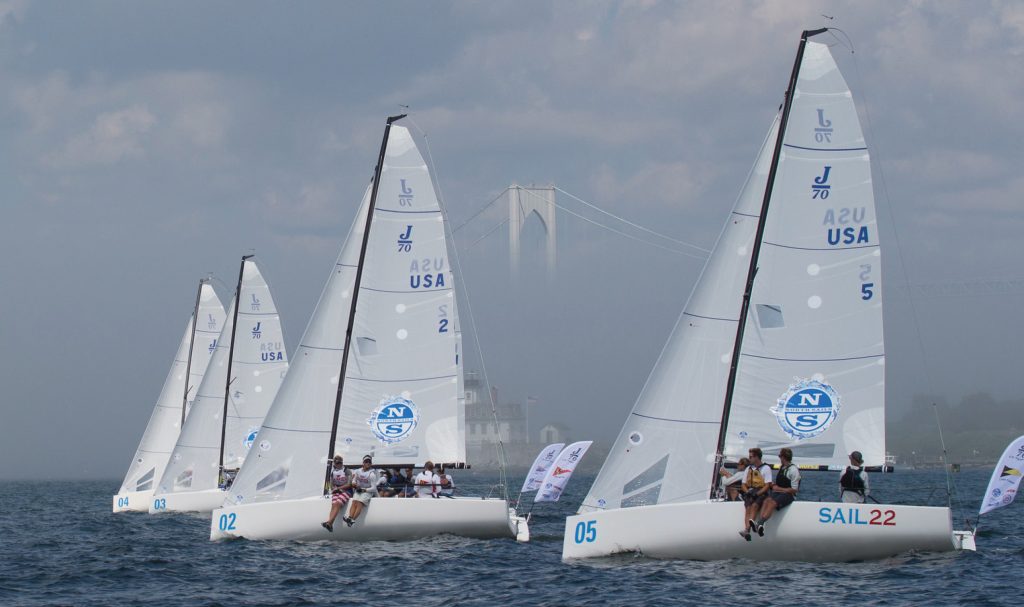When you’re trying to fight your way to the front of any fleet, there are three tactical goals to keep in mind. First, you must be able to sail your boat as fast as possible. Simply put, you have to avoid the bad air of other boats.
Your second goal is to keep your strategic options open. That is, you must maintain the ability to go left or right, depending on what happens with the wind. If other boats prevent you from tacking, for example, then you have given up options and lost control.
A third tactical goal is to put yourself in the right spot relative to other boats so you are likely to make gains (or avoid losses). This kind of positioning includes covering when you are ahead and staying on the favored side of your nearby competitors.
Tactics is all about how you position your boat with respect to other boats. A strong tactical position is one where you have both clear air and control of your own destiny. You can go where you want with minimal interference from other boats.

Position is critical to your success on the racecourse, especially in ultra-competitive fleets such as the inaugural U.S. J/70 Youth Championship, which was hosted by Sail Newport in August 2017. © Julia Cronin/Outrageous Photography
Here are some of the skills you need in order to be successful tactically:
• Good boathandling: If you want to mix it up with the fleet, you must be smooth and fast.
• Knowledge of the Rules: To maneuver in close quarters you need a pretty good understanding of the racing rules; otherwise you will feel intimidated and other boats will be able to take advantage of you.
• Crew communication: Work together so everyone knows the strategy you are pursuing and your potential tactical moves.
• Anticipation: Your goal is to use smart tactics to help you follow your strategic plan. This means you must always have your game plan in mind, and you have to keep your head out of the boat so you see what’s coming. The last thing you want is a surprise starboard tacker with no time for deciding what to do.
A. Set up on the favored side of other boats.
If your strategy says play the right side, it may not be enough simply to sail toward that part of the first beat. That’s because if the rest of the fleet goes even farther right, you are actually on the left, at least tactically. Since your goal is to beat the other boats, you must position yourself to their left or right depending on strategic factors.
If the right side of the course is favored, for example, you should stay on the right of your competition. In most cases, it’s better to set up on the side of the other boat(s) that puts you closer to the middle of the course. By staying to leeward and ahead on the long tack to the mark, you’re in better position to play the shifts and make gains.
B. When in doubt, protect the right side of the course.
Usually you pick a side of the course based on strategic factors, but occasionally you go one way because of tactics. When wind and current are equal across the course, consider playing the right side since this will give you the starboard-tack advantage when you converge with other boats. This is most important when you are even with a lot of boats or when you’re getting close to the windward mark.
C. Use a “blocker” to protect your lane on starboard tack.
Sometimes you can actually use the position of other boats to help you follow your strategy.
D. Don’t set up too close on either side of another boat.
Unless you are using another boat as a blocker, it’s generally a good rule of thumb to stay away from other boats. Having another boat nearby often limits your strategic options, brings the problem of bad air, and/or presents potential rules difficulties.
E. Take advantage of (or beware of) the “leebow position.”
One strong tactical move is to set up in a so-called “safe leeward position.” When you are just to leeward and ahead of another boat, you will be sailing in a slight lift as the wind bends around that boat’s sail plan. At the same time, your competitor will have a header coming off your sails, so you will soon pull ahead.
You normally get into this position by approaching on port tack and then tacking. However, you must be at least bow to bow with the other boat as you converge in order to make this work. Make sure you don’t tack too close to them, or you’ll break Rule 13 (Changing Tacks). Also, don’t tack too far away or you won’t slow them and they’ll then pin you from tacking. Once you tack into a leebow position, work hard at pointing high and squeezing to windward so you force the other boat to tack away quickly. This is essential in order to regain the strategic option to tack whenever you want.
This article originally appeared in David Dellenbaugh’s Speed & Smarts, The newsletter of how-to tips for racing sailors. If you want to sail faster and smarter, log onto SpeedandSmarts.com.
A resident of Easton, CT, Dellenbaugh was tactician and starting helmsman for America3’s successful defense of the America’s Cup in 1992. He’s a Lightning World Champion, two-time Congressional Cup winner, seven-time Thistle National Champion, two-time winner of the Canada’s Cup, three-time Prince of Wales U.S. Match Racing Champion, and a winner of the U.S. Team Racing Championships for the Hinman Trophy.




